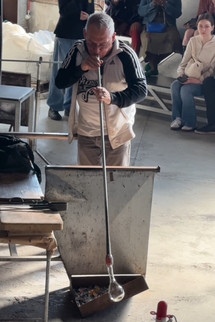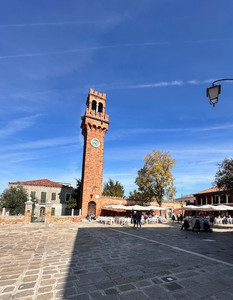Murano Venezia
- Maria Scuor
- 1 day ago
- 9 min read
Italiano sotto ogni sezione
Murano is a series of Islands that are linked by bridges in the Venetian Lagoon and is about 1.5 km (1 mi) north of Venice. It measures 1.5 km (1 mi) across and has a population of about 5000 people. It was once an independent comune but is it now a frazione (subdivision) of the comune of Venice. Murano is famous for its glass making.
Originally settled by the Romans but later in the 6th century by people from Altinum and Oderzo. Back then it prospered as a fishing porta as well as its production of salt. In the 11th century, the islanders moved to Dorsoduro therefore Murano began to decline. It had its own Grand Council but by the 13th century it was governed by a podestà from Venice. Unlike the other islands in the Lagoon, Murano minted its own coins.
Venetian glassmaking in factories existed as far back as the 8th century in Venice. However, in 1291 the government passed a law that all glass factories had to move to Murano. This was because glass factories often caught on fire and this could be disastrous for Venice where buildings are all connected. Another reason was that Venetian glassmakers had developed secret recipes and methods for making glass and having the glassmaking on the island enabled better control of the secrets.
By the 14th century, exports began and the island became famous for glass beads and mirrors. The glassmakers were among the island’s most prominent citizens who were allowed to wear swords, had immunity from prosecution by the Venetian state and their daughters married into Venice’s most affluent families. These were all perks because glassmakers were forbidden to leave the republic. However, many migrated and established glass furnaces as far as England and Netherlands.
Murano had the monopoly on high-quality glassmaking for centuries. They developed and refined many technologies. Today, the artisans still use these centuries-old techniques, making everything from contemporary art glass and glass jewellery to incredible glass chandeliers.
While we were in Murano, we went to the Murano Glass Factory and watched a glass master blow glass into a vase and transform hot glass into a prancing horse.
Creating a glass vase - Creazione di un vaso di vetro
Creating a glass horse - Creare un cavallo di vetro
Beautiful glass creations - Bellissime creazioni in vetro

Murano Venezia
Murano è una serie di isole collegate da ponti nella laguna veneziana e si trova a circa 1,5 km a nord di Venezia. Misura 1,5 km di diametro e ha una popolazione di circa 5000 persone. Un tempo era un comune autonomo ma ora è una frazione del comune di Venezia. Murano è famosa per la lavorazione del vetro.
Originariamente abitato dai Romani, ma più tardi, nel VI secolo, da popolazioni provenienti da Altinum e Oderzo. All'epoca prosperava come porta da pesca e come produzione di sale. Nell'XI secolo, gli isolani si trasferirono a Dorsoduro, quindi Murano iniziò il declino. Aveva un proprio Gran Consiglio, ma dal XIII secolo era governato da un podestà di Venezia. A differenza delle altre isole della Laguna, Murano ha coniato le proprie monete.
La lavorazione del vetro veneziano nelle fabbriche esisteva già nell'VIII secolo a Venezia. Tuttavia, nel 1291 il governo approvò una legge che imponeva che tutte le vetrerie dovessero trasferirsi a Murano. Questo perché le vetrerie spesso prendevano fuoco e questo poteva essere disastroso per Venezia, dove gli edifici sono tutti collegati. Un altro motivo era che i vetrai veneziani avevano sviluppato ricette e metodi segreti per fare il vetro e avere la lavorazione del vetro sull'isola permetteva un migliore controllo dei segreti.
Nel XIV secolo iniziarono le esportazioni e l'isola divenne famosa per le perle di vetro e gli specchi. I vetrai erano tra i cittadini più importanti dell'isola a cui era permesso di indossare spade, avevano l'immunità dai procedimenti giudiziari da parte dello stato veneziano e le loro figlie si sposavano con le famiglie più ricche di Venezia. Questi erano tutti vantaggi perché ai vetrai era proibito lasciare la repubblica. Tuttavia, molti migrarono e stabilirono fornaci di vetro fino in Inghilterra e nei Paesi Bassi.
Murano ha avuto per secoli il monopolio della lavorazione del vetro di alta qualità. Hanno sviluppato e perfezionato molte tecnologie. Oggi, gli artigiani usano ancora queste tecniche secolari, realizzando di tutto, dal vetro d'arte contemporanea e dai gioielli in vetro agli incredibili lampadari di vetro.
Mentre eravamo a Murano, siamo andati alla Vetreria di Murano e abbiamo visto un maestro vetraio soffiare il vetro in un vaso e trasformare il vetro caldo in un cavallino rampante.
More things we saw on the island - Altre cose che abbiamo visto sull'isola:
Rio of the Glassmakers - Rio dei Vetrai
Rio dei Vetrai is a canal on Murano Island. It is about 500 metres (1640 ft) long and connects the Canale Grande of Murano with the Canale dei Marani. As we walked along the canal, we can see this is the place where most of the glassworks of Murano are. Shops and factories line the canal and the artwork is absolutely beautiful.
You can cross the canal at three bridges; San Pietro Martire Bridge, Middle Murano Bridge and Santa Chiara Bridge
Photos of Rio of the Glassmakers – Foto di Rio dei Vetrai
Rio dei Vetrai
Il Rio dei Vetrai è un canale dell'isola di Murano. È lungo circa 500 metri e collega il Canale Grande di Murano con il Canale dei Marani. Mentre camminavamo lungo il canale, possiamo vedere che questo è il luogo in cui si trovano la maggior parte delle vetrerie di Murano. Negozi e fabbriche fiancheggiano il canale e le opere d'arte sono assolutamente bellissime.
È possibile attraversare il canale in corrispondenza di tre ponti; Ponte di San Pietro Martire, Ponte di Murano Medio e Ponte di Santa Chiara
Campo Santo Stefano
Campo Santo Stefano is a square across from Chiesa San Pietro Martire. When we walked by there, we could see table and chairs for people to enjoy sitting and watching the beautiful scenery of the St Peter Martyr Church, the Rio dei Vetrai canal which can be crossed at this point over the San Pietro Martire Bridge.
Murano, like Venice, at the time of the Republic didn’t have a “secular” tower that would have marked the times of the community through bells, warned citizens of council sessions, or even reported dangers, alarms or capital executions. Instead, it had the bell tower of the matrix of Saints Mary and Donato with its three bells “voices” Grande, Mezana and Picola that became the religious and civil voice of the community of Murano.
However, when the Republic fell, abbot Vincenzo Zanetti launched through his newborn newspaper La Voce di Murano, a proposal to erect a civic tower in Campo Santo Stefano, in 1867. His idea was to place a clock and bell to mark the times and become the “universal” voice of the citizens. His hope was the “torrincella” would be built on the foundations of the ancient bell tower of the pieve of San Stefano.
In 1888, five years after abbot Zanetti died the Mayor of Murano, Giobatta Mazzega resumed the idea, after a period of economic depression. The project presented by Mr. Vendrasco was approved, with "technical" additions to the foundation of Engineer Fantino Bon. The tower was completed on August 21, 1890 and the clock was put into operation on June 7, 1891.
Many didn’t like the "medievalizing" style of the tower as it wasn’t "very Venetian". In fact, it seemed to be inspired by the crenellated one of Palazzo Vecchio, in Florence, and the Del Mangia one, in Siena. But it achieved its goal of being the universal voice of the citizens.
Photos of Campo Santo Stefano – Foto di Campo Santo Stefano
Campo Santo Stefano
Campo Santo Stefano è una piazza di fronte alla Chiesa San Pietro Martire. Quando siamo passati di lì, abbiamo visto tavoli e sedie per le persone che si sono divertite a sedersi e guardare lo splendido scenario della Chiesa di San Pietro Martire, il canale del Rio dei Vetrai che può essere attraversato in questo punto sul Ponte di San Pietro Martire.
Murano, come Venezia, ai tempi della Repubblica non aveva una torre "laica" che scandisse i tempi della comunità attraverso campane, avvertiva i cittadini delle sedute conciliari, o addirittura segnalava pericoli, allarmi o esecuzioni capitali. Aveva invece il campanile della matrice dei Santi Maria e Donato con le sue tre campane "voci" Grande, Mezana e Picola che divenne la voce religiosa e civile della comunità di Murano.
Tuttavia, alla caduta della Repubblica, l'abate Vincenzo Zanetti, attraverso il suo neonato giornale La Voce di Murano, lanciò la proposta di erigere una torre civica in Campo Santo Stefano, nel 1867. La sua idea era quella di posizionare un orologio e una campana per scandire i tempi e diventare la voce "universale" dei cittadini. La sua speranza era che la "torrincella" sarebbe stata costruita sulle fondamenta dell'antico campanile della pieve di Santo Stefano.
Nel 1888, cinque anni dopo la morte dell'abate Zanetti, il sindaco di Murano, Giobatta Mazzega riprese l'idea, dopo un periodo di depressione economica. Il progetto presentato dal Sig. Vendrasco fu approvato, con aggiunte "tecniche" alla fondazione dell'Ingegner Fantino Bon. La torre fu completata il 21 agosto 1890 e l'orologio fu messo in funzione il 7 giugno 1891.
A molti non piaceva lo stile "medievalizzante" della torre in quanto non era "molto veneziana". Sembrava infatti ispirarsi a quella merlata di Palazzo Vecchio, a Firenze, e a quella del Mangia, a Siena. Ma ha raggiunto il suo obiettivo di essere la voce universale dei cittadini.
St. Peter Martyr Church – Chiesa San Pietro Martire
As we walked across the San Pietro Martire Bridge you literally walk right into the side of the San Pietro Martire church. It is a Roman catholic parish that was built in 1348 with a Dominican convent and it was dedicated to St. John the Baptist. In 1474, it was demolished by a fire that burnt it to the ground.
It was rebuilt in 1522 to its current appearance. During the fall of the Republic of Venice and Napoleon’s mandate to supress religion, it was closed in 1806 and reopened in 1813. It is currently one of two parishes on the island of Murano.
The façade is plain brickwork and divided in three sections. It has a 16th century portal which has a large rose window over top of it. On the left façade is a portico with Renaissance arcades and columns and what remains of the original cloister. On the same side it the bell tower which dates back to 1498-1502.
The interior has a basilica plan, with a wooden ceiling and three naves divide by two series of large columns. The presbytery is very large, with barrel vaults and two small side chapels. There is a high altar and minor altars in the naves. There are several pieces of art dating from the early 1500s.
Photos of exterior – Foto degli esterni
Photos of interior – Foto degli interno
Chiesa San Pietro Martire
Mentre attraversavamo il Ponte di San Pietro Martire, si camminava letteralmente proprio nel lato della chiesa di San Pietro Martire. Si tratta di una pieve cattolica romana che fu costruita nel 1348 con un convento domenicano e fu dedicata a San Giovanni Battista. Nel 1474 fu demolita da un incendio che la rase al suolo.
Fu ricostruita nel 1522 fino all'aspetto attuale. Durante la caduta della Repubblica di Venezia e il mandato di Napoleone di sopprimere la religione, fu chiuso nel 1806 e riaperto nel 1813. Attualmente è una delle due parrocchie dell'isola di Murano.
La facciata è in mattoni semplici e divisa in tre sezioni. Ha un portale del XVI secolo che ha un grande rosone sopra di esso. Sulla facciata sinistra si trova un portico con arcate e colonne rinascimentali e ciò che resta del chiostro originario. Sullo stesso lato si trova il campanile che risale al 1498-1502.
L'interno è a pianta basilicale, con soffitto ligneo e tre navate divise da due serie di grandi colonne. Il presbiterio è molto ampio, con volte a botte e due piccole cappelle laterali. Nelle navate si trovano un altare maggiore e altari minori. Ci sono diverse opere d'arte risalenti ai primi anni del 1500.
Final thoughts - Riflessioni finali
Murano is a beautiful little island that is colourful because of all the windows that have amazing colourful glass works. It is wonderful to walk along the canal and think about what it must have been like in the 1300s when the town was busy with everyone making precious pieces of glass. It truly is a “MUST SEE” town if you are visiting Venezia.
Riflessioni finali
Murano è una bellissima isoletta colorata grazie a tutte le finestre che hanno incredibili opere in vetro colorato. È meraviglioso passeggiare lungo il canale e pensare a come doveva essere nel 1300, quando la città era impegnata con tutti a fare preziosi pezzi di vetro. È davvero una città "DA VEDERE" se stai visitando Venezia.






























































































Comments